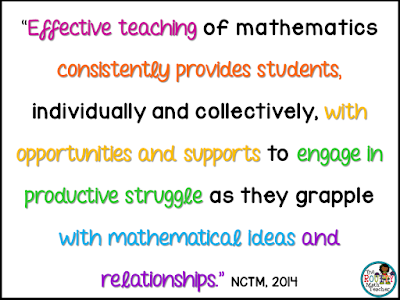
Welcome back! Last week, I presented a list of expectations for both students and teachers during productive struggle and provided an opportunity to see productive struggle in action via a Teaching Channel video. (Read Part 3 here.) Today, I want to connect productive struggle with growth mindsets and share a great resource with you.
Susan Carter (2008) introduced her first grade class to the concept of disequilibrium to help them better understand and identify the discomfort they felt when they solved math problems. This allowed her students to do two things. First, it let them know that it was okay not to know the answer to a problem right away. Second, it "gave them permission to struggle" (p. 136). NCTM (2014) advocates that "teachers must accept that struggle is important to students' learning of mathematics, convey this message to students, and provide time for them to try to work through their uncertainties" (p. 50).
This idea of disequilibrium is so important for students to understand as many people believe that math is either right or wrong. They believe that there is only one answer and there is a process, or series of steps, to take to get to the solution. Students, and teachers, who view mathematics in this way cripple themselves because they miss a major component in the successful learning of mathematics-- growth is the result of struggling through a process. Remember Lev Vygotsky's "zone of proximal development" that was discussed in Part I? (Read about it here.) Growth occurs between what we can do alone and what we cannot do.
So where then do growth mindsets fit in? Despite the willingness of a teacher to allow students to work through disequilibrium at their own pace, some students will still shut down when they reach their frustration point because they foster a belief that being good at math is an intelligence which you have at birth-- you either have it or you don't. Research conducted by Carol Dweck (2006) has termed this type of thinking as having a "fixed mindset." On the other hand, those students with a "growth mindset" (Dweck, 2006) believe that the intelligence needed to be successful in mathematics can be gained through effort. These students are more likely to tackle a challenge because they view it as "an opportunity to learn and grow" (NCTM, 2014, p. 50).
How do we promote a growth mindset in our students?
- acknowledge and show value for the effort that students make
- ask questions that allow students to move forward without giving away the answer or solution strategy
- provide specific feedback on students' progress
- reinforce the idea that struggle is part of the process
Want to learn more about mindsets? Join The Routty Math Teacher and 12 other bloggers for a collaborative book study focusing on Jo Boaler's Mathematical Mindsets. Grab a copy of the book and read along with us or join us online for chapter summaries, biggest takeaways, and tips for applying the new learning in the classroom. The study goes live on Thursday, July 7th.
Stay tuned next week for Chapter One of Mathematical Mindsets!
Sound Off! What are some other ways we can promote a growth mindset in our students?
References:
- Carter, S. (2008). Disequilibrium and questioning in the primary classroom: Establishing routines that help students learn. Teaching Children Mathematics, 15(3), pp. 134-37.
- Dweck, C. (2006). Mindset: The new psychology of success. New York: Random House.
- National Council of Teachers of Mathematics. (2014). Principles to actions: Ensuring mathematical success for all. Reston, VA: National Council of Teachers of Mathematics.


























